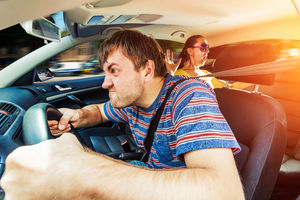Anger
The Road to Rage
From aggressive driving to anger, arguments and assault.
Posted March 30, 2018

We’re all well aware of the dangers when we get behind the wheel of a car—the perils of drinking and driving, the dangers of slippery roads, the risk of a speeding, careless or distracted motorist. Few of us, however, worry about getting hit with a baseball bat or shot to death before we arrive at our destination.
And, while statistics suggest that we shouldn’t worry about it too much, they also indicate that road rage causes a small, but increasing percentage of deaths on U.S. roadways. According to the National Highway Traffic Safety Administration, road rage was linked to 467 fatal crashes in 2015, up 500 percent from the 80 recorded in 2006. And the number of firearms used during a road rage more than doubled between 2014 (247 incidents) to 2016 (620).
Here are examples of news headline over the week between March 20 and March 27, 2018.
“Family, Friends, Mourn Death of Teen Killed in Road Rage Incident.”
“Plantation [Florida] Woman Hit with Baseball Bat in Road Rage Attack.”
“Road Rage Stabbing Not Typical, Greensburg Police Say.”
“Road Rage Incident Leads to Shooting at Apartment Complex.”
I want this blog to be more than just a cautionary tale, so let's look at how we can keep our tempers in check while driving, avoid (as much as possible) being a road rage victim, and learn what to do if we encounter a hostile driver.
What is Road Rage and How Does It Happen?
That depends on how you define it. According to various surveys, about 80 percent of us have gotten pretty ticked off at another driver at some point during the past year. There also seems to be some confusion between aggressive driving and road rage. Aggressive driving is anything we do that is risky, dangerous and often doesn’t follow the law; speeding, tailgating, and blocking someone from merging into our lane because we’re ticked off are good examples. Road rage is more extreme; it involves physically harming a person or his/her vehicle—running a driver off the road, ramming his/her car from behind, getting into a fight with another driver, or using a weapon to cause harm.
Road rage is complicated. We know that certain traffic conditions, such as overcrowding on the highway, sets the stage for conflict between drivers. We also know that certain behaviors—being cut off by another driver, encountering a slowpoke in the left lane, being behind someone who turns abruptly without signaling first—makes just about anyone mad. When this happens, some of us feel the need to retaliate, either because we’re already stressed out (running late, just got into a fight with our spouse, or some other situational problem) or because we have a short fuse and tend to take others’ mistakes personally. So, we up the ante; yell at the “stupid” driver or give him or her “the finger.” What happens next depends on the people involved.
Here’s how one scenario played itself out in real life. The stabbing victim, whom we’ll call Driver A, stated that he almost ran into the back of the perpetrator’s (aka Driver B) car because Driver B slammed on the brakes right in front of his car. Driver B stated that he was first cut off by Driver A. Angry, Driver A followed Driver B into a Shop ‘n Save parking lot, where Driver B works. Driver A got out of his car, confronted Driver B, the two argued, began fighting, and Driver B stabbed Driver A underneath his ribs. Driver A is in the hospital and Driver B has been charged with criminal intent to commit homicide, aggravated and simple assault, terroristic threats, and endangering another person.
Most tussles between drivers are defused long before they reach the stabbing point. But here’s the thing to remember; we don’t know what we’re getting into if we angrily confront a distracted or aggressive driver. Maybe it'll be an apologetic out-of-towner who's erratic driving is because she"s lost. But maybe we'll meet a loose cannon with a short fuse whose just hankering for a fight. A minor traffic incident isn’t worth dying over.
So How Do We Keep from Being a Victim?
Our best defense against road rage is a good offense; be courteous to other drivers, pay attention, and acknowledge any mistakes. Don't text and drive, eat and drive, or do anything that will put other drivers at risk. It' not that stellar driving guarantees our avoidance of an angry motorist, but, given that anger is a secondary emotion that often kicks in when we're afraid or hurt, few things get our blood boiling more than believing someone else's carelessness or selfishness is putting us in danger.
So what should we do if another driver tries to start a conflict? Don’t engage. Don’t respond to rude gestures, belligerent honking, or verbal insults. Instead, put as much distances between the two of you as possible. If you are being tailgated, change lanes. If someone wants to pass, slow down and let them. If possible, stay behind the angry driver and, if it would make you feel safer, take the next exit and let them go on by. Whatever you do, don’t pull over to the side of the road to “talk it out” and never drive home or to work if you are being followed. Instead, drive to a safe location, such as a local police station or fire department, and if you ever believe you are in imminent danger, call the police.
Keeping Our Cool on Hell’s Highways
So how do we keep our own cool in the face of a driver who either seems completely clueless to the rules of the road or who doesn’t seem to care? Here are a few strategies that might help.
Give yourself extra time to get where you're going. Few things are as stressful as time pressure, especially when we’re trying to get somewhere important.
Create a stress-free car climate. Listen to calming music or a soothing meditation program. Hang a peppermint or cinnamon air freshener; according to a NASA-funded study, these scents lower frustration and increase alertness. Put pictures of your loved ones on your dashboard; not only will their faces make you happy, they serve as a gentle reminder that you have people worth safely coming home to. And don’t continue arguments in the car—with other passengers or by cellphone. It’s a lot easier for anger to spill over to a fellow driver when the pot has already been stirred.
Listen to the backseat drivers who love you. No one likes to be told how to drive, but if you’re getting a chorus of safety complaints about your risky driving, maybe it’s time to slow down and listen.
Monitor what you say to yourself. That “bozo” or “moron” who screeched to a halt at the traffic light could be a man trying to get his laboring wife to the hospital for the birth of their child, or a woman who just found out her spouse had a heart attack. Encased in our cars, it’s easy to forget that each driver is a person who hopes, dreams, loves and has problems. Thinking of alternative explanations for another driver’s mistakes can help us keep that in mind. It also reduces hostility, a major risk factor for heart attacks.
I cringed a few times while writing this blog; when it comes to peaceful driving, I’m a work in progress. But I am convinced it’s worth the effort, both for our safety and our health. Be careful, my friends.




